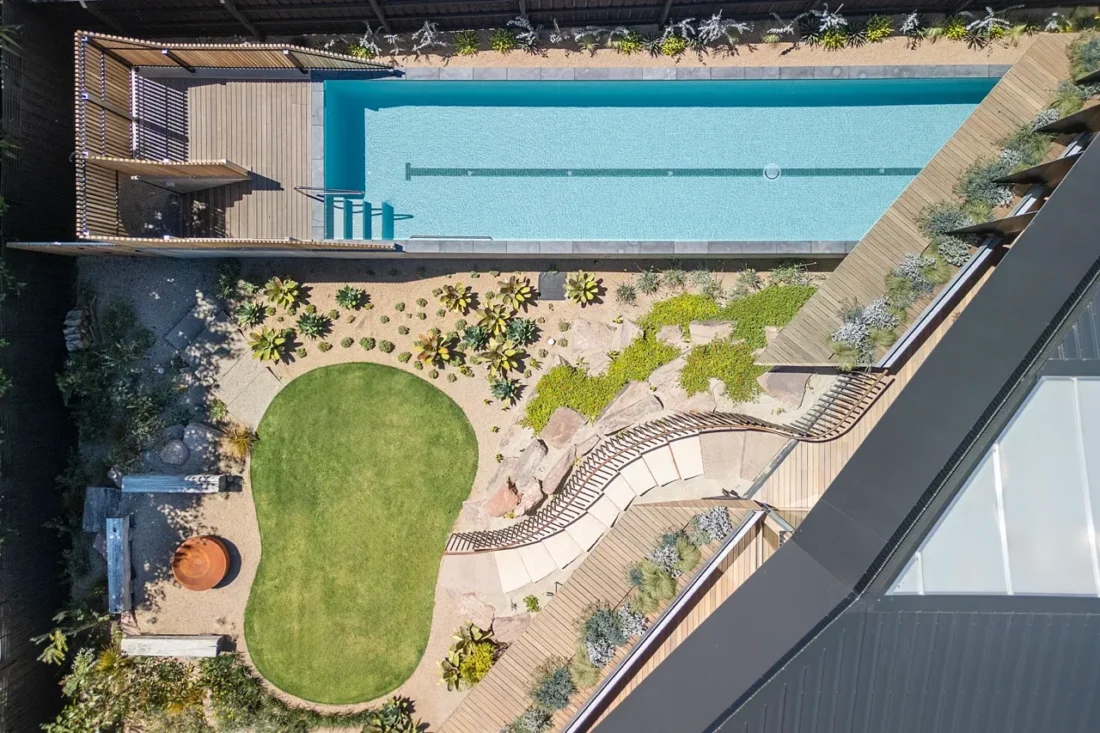
5 Considerations When Designing a Lap Pool
Are you considering a lap pool for fitness, rehabilitation, or relaxation? Perhaps all three? Designing the perfect lap pool involves more than just choosing the right shape and size. From our experience, here’s what you should be considering to create the best lap pool, swimming experience for everyone.
LEARN MORE
Lap Pool Dimensions: Length, Width & Depth
There’s no one-size-fits-all length for a lap pool, but the longer the better, to minimise turns. Common lengths for domestic lap pools are 12.5m, 15m, 20m, and 25m. Of course, one of the great advantages of concrete pools is that they can be constructed to any size to suit your requirements. We have many clients who build lap pools down to 8m. While this size may not be the most practical for lap swimming, it may be better suited for rehabilitation exercises and family play.
As far as width goes, a good comparison is that lap lanes at most commercial swim centers are 2.5m wide, accommodating two swimmers. The backyard lap pools we have constructed generally range from 1.5m to 4m wide, with 2 m- 2.5 m being the most popular. When thinking about pool depth, a key consideration is whether you want to be able to dive from one end. If so, the pool should be 2.0 m deep. Many modern lap pools are 1.2m throughout. This depth allows for a swimmer to turn, while also being more affordable to maintain and build due to less water and material volume. Essentially, think about how many swimmers will use the pool once, how many strokes you want per lap, and whether diving is important for your routine.
Lap Pool Heating Options: Swim More Months, Spend Less
How many months of the year do you want to use your pool? This answer will help you determine the best heating system for your lifestyle. Solar heating is perfect for those wanting to swim summer afternoon laps at around 25 degrees. If you want to swim all year round, or early mornings, you will most likely need to consider some other type of heating; typically gas heating or a heat pump. Your builder will be able discuss your options with you to help you decide.
Lap Pool Covers & Enclosures: Keep Heat In, Keep Costs Down
If you are looking to keep your pool heated all year round, a pool cover is a great way to maintain heat in the pool, in turn conserving energy costs. Nowadays, there are a number of retractable polycarbonate domes available that offer the best of both words. Another method is to install an outdoor cover. This can be a simple thermal blanket on a roller, or a fully automated Remco Swimroll that will retract in under the pool. If you have the space, you may decide to build the pool indoor for a year round facility. This can be a great option, but also can be more costly and doesn’t always allow you to enjoy those sunny days by the pool.
Lap Pool Design for Rehab & Exercise
Lap pools are excellent for rehabilitation and low-impact exercise, as water provides a natural resistance while reducing strain on joints and muscles. To further expand the rehabilitating abilities of your lap pool, adding an underwater grab rail for kicking and support in other exercise activities is a great option. Adding a spa to your lap pool can further enhance muscle relaxation and recovery, while also making the pool more year-round friendly.
Lap Pool Design for Families and Entertaining
Lap pools are great for exercise, however, if you have a young family or are frequently entertaining, it can be great to add an offset area for general play, or swim outs to increase shallow play and seat space. Spas and water features can also transform the space into a feature that satisfies everyone.
Lap Pool Access and Safety
If your pools is being used for swimming laps, the last thing you need are internal steps to swim into. A great solution to this is considering offset steps or niche wall steps with a stainless steel grab rail. These are both easy access solutions, and won’t impact the flow of your swimming.
If you are ready to start designing your lap pool, please call us on (03) 9870 5282 or contact us via the contact from below.
"*" indicates required fields




